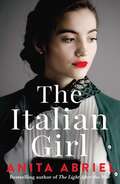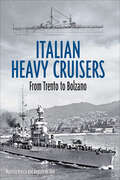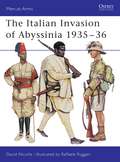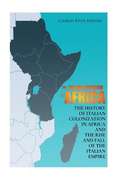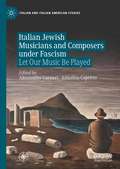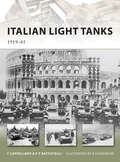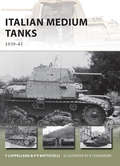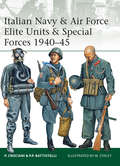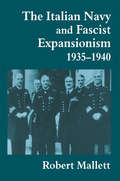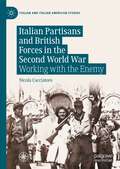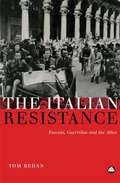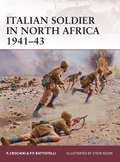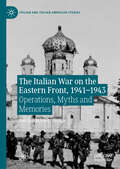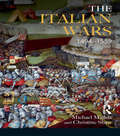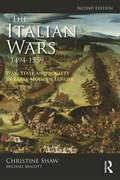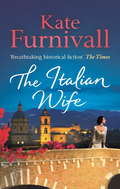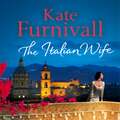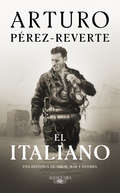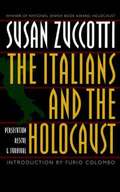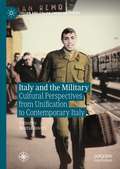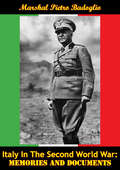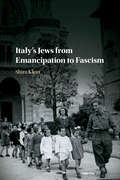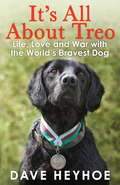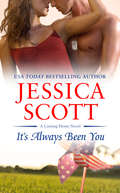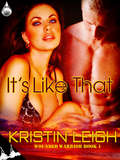- Table View
- List View
The Italian Girl
by Anita AbrielA fearless young Italian woman risks everything to save precious artworks from the Nazis in a gripping new tale from the bestselling author of The Light After the War. Rome, 1943: Marina Tozzi adores her father Vittorio and working together in his art gallery is her only escape from the reality of the Nazi occupation. Not only has Marina inherited her father&’s passion for art but she is earning a reputation as an expert in her own right. However, Vittorio is keeping a deadly secret from his daughter. He has been hiding a Jewish artist in their basement and one day Marina returns home to find her father has been brutally murdered by a German officer. Devastated, Marina flees to Florence to seek help from a man who owes Vittorio his life. Renowned American art expert Bernard Berenson offers Marina sanctuary in his villa outside Florence and a job cataloguing his vast art library. Marina is grateful but she is determined to find a way to avenge her father. When handsome young artist Carlos proposes using her expertise to help the partisan cause against the Nazis, she has at last found her purpose. In one daring and ingenious act, Marina risks her life to save a priceless painting from falling into Nazi hands and proves her worth to the partisans. But falling in love with Carlos was not part of her plan. When Carlos suddenly disappears, Marina&’s dreams about building a life with him after the war turn to ashes. She will have to travel halfway around the world to unravel the past – and find her future.Praise for Anita Abriel &‘I was utterly moved and transfixed&’ Kristin Harmel &‘Fans of historical fiction won&’t want to miss this evocative, heartbreaking story&’ Beatriz Williams &‘Beautifully written and heartfelt&’ Jillian Cantor
Italian Heavy Cruisers: From Trento to Bolzano
by Maurizio Brescia Augusto de ToroWhen the Washington Naval Treaty of 1922 effectively banned the building of battleships, competition between the major navies concentrated on the next most powerful category, heavy cruisers limited to 10,000 tons displacement and 8-inch guns. Italy followed this trend, the first design for what became Trento and Trieste being ordered in 1924. These were the fastest of the first generation ‘Treaty’ cruisers but were very lightly armored, and the succeeding Zara class of four ships were slower but better protected. However, before the final ship of this class (Pola) had been completed, there was a return to the earlier fast, lightly protected concept with the Bolzano, although this ship also incorporated aspects of the Zara design. The political background, design history and technical features of these classes are covered in great depth in this volume. They were important ships, subject to incremental improvement so no two were identical, and modelmakers in particular will appreciate the space devoted to the variations in appearance, using both description and illustration. As major units of the Italian battlefleet, they were more active than most during the war and their careers are fully detailed, including analyzes of damage suffered. Tragically, they were all sunk and the full circumstances of each loss is explored. As befits a technical history, the book is thoroughly illustrated with ship and armament plans, detail drawings and color camouflage schemes, as well as an outstanding collection of photographs. Translated from the same series that produced the highly successful Italian Battleships, this volume is a fitting companion.
The Italian Invasion of Abyssinia 1935-36
by David Nicolle Raffaele RuggeriThe Second Italo-Abyssinian War began in October 1935, when Mussolini ordered the invasion of Ethiopia from Italian-held Eritrea and Somaliland, thinking that he would easily crush an ill-prepared and badly equipped enemy. The Italians, in the face of widespread condemnation from the League of Nations, spread terror and destruction through their indiscriminate use of air power and poison gas against an enemy more used to Medieval methods of warfare. David Nicolle examines in detail the units, equipment and uniforms of the forces on both sides of this conflict that unrealistically bolstered Il Duce's colonial ambitions. A great read ably supported by Raffaele Ruggeri's detailed full-page colour plates.
The Italian Invasion of Africa: The History of Italian Colonization in Africa and the Rise and Fall of the Italian Empire
by Charles River EditorsWhen World War II broke out, Italy’s alignment with Nazi Germany meant that Italian possessions in Africa would turn the region into a crucial theater at the start of the war, and ultimately, the Italians’ inability to stave off the Allies in Africa would lead to further German involvement there, at a time when Hitler could least afford to draw resources away from the fight against the Soviets. All of it would culminate in one of the most famous battles of the war at El Alamein, pitting the legendary Desert Fox, Erwin Rommel, against the British.
Italian Jewish Musicians and Composers under Fascism: Let Our Music Be Played (Italian and Italian American Studies)
by Alessandro Carrieri Annalisa CapristoThis book is the first collection of multi-disciplinary research on the experience of Italian-Jewish musicians and composers in Fascist Italy. Drawing together seven diverse essays from both established and emerging scholars across a range of fields, this book examines multiple aspects of this neglected period of music history, including the marginalization and expulsion of Jewish musicians and composers from Italian theatres and conservatories after the 1938–39 Race Laws, and their subsequent exile and persecution. Using a variety of critical perspectives and innovative methodological approaches, these essays reconstruct and analyze the impact that the Italian Race Laws and Fascist Italy’s musical relations with Nazi Germany had on the lives and works of Italian Jewish composers from 1933 to 1945. These original contributions on relatively unresearched aspects of historical musicology offer new insight into the relationship between the Fascist regime and music.
Italian Light Tanks
by Richard Chasemore Filippo CappellanoThe Italian army, unlike those of the British and French, did not use tanks in combat during World War I and, by November 1918, only one training unit equipped with French Schneider and Renault tanks had been formed. Consequently, during the 1920s the Italian army had just one single tank type in its armoured inventory - the Fiat 3000. Only in 1927 was the first tank unit formed as a branch of the infantry and not as an independent organization, while the cavalry rejected the idea of both tanks and armoured cars and decided to stand by the use of horses for its mounted units. Between 1933 and March 1939, a further 2,724 CV 33 / L 3 tanks were built, 1,216 of which were exported all over the world. By the time Italy entered the war in June 1940, the army had 1,284 light tanks, 855 of which were in combat units, including three armoured divisions. Variants of the CV 33 / L 3 tanks included flame-throwers, bridge-layers, recovery vehicles, and a radio command tank. Some L 3 tanks were still in use in 1945, by both the Germans and the German-allied Italian units of the Repubblica Sociale.
Italian Medium Tanks
by Pier BattistelliSeveral factors delayed and greatly hampered the development of an Italian medium and heavy tank during Rommel's Desert War in World War II. The first was the strategic stance of the country, focussed on a war against neighbouring countries such as France and Yugoslavia, and ill-prepared for a war in the Western Desert. Since these European countries bordered with Italy in mountainous areas, light tanks were preferred as these were deemed much more suitable for the narrow roads and bridges of the Alps. The failure to develop an effective operational plan for North Africa was another factor behind the failed development of an Italian medium tank, along with the lack of communication between the War Department and the Ministry of the Colonies, which not only had actual command over the Italian forces deployed in the Italian colonies of Libya and in Italian East Africa, but was also responsible for developing their defence plans. Furthermore, the development of the medium tank was hampered by the limited number of Italian industries, whose production was also heavily fragmented - hence the SPA-developed engines, the Fiat and Ansaldo hulls and armour, the Breda and army ordnance guns. All these factors delayed the development of the first prototype of an Italian medium tank - the M 11 - which would only appear in 1937 and did not enter production until 1939.Inspired by its British and French counterparts, the M 11 / 39 was a 11-ton medium tank chiefly intended for use as an infantry tank, with its main gun (a 37/40 gun) mounted in a casemate in the hull and its small turret armed only with two machine guns. Actual production was limited to only 100 samples, 76 of which were sent to Libya and the other 24 to Eastern Africa, as production of the turret-gun-armed M 13 had started in the meantime. In June 1940, when Italy entered the war, her armoured inventory numbered fewer than 1,500 light tanks (including the obsolete Fiat 3000) and the 100 newly built M 11 medium tanks, divided amongst three armoured divisions, three cavalry groups and several independent tank battalions. Unsurprisingly, without a tank school, the Italian armoured force lacked the necessary training and experience in the use of tanks and AFVs, and with the tanks lacking radio equipment, there was a widespread absence of tactical and technical knowledge which, along with the limited effectiveness and numbers of the available tanks, made the perfect recipe for the defeats to come.From the Trade Paperback edition.
Italian Navy and Air Force Elite Units and Special Forces 1940-45
by Piero Crociani Mark StaceyThis volume assesses the formidable Special Forces fielded by Italy's navy and air force in World War II. Italian Navy Special Forces were particularly active and respected in the Mediterranean, where 10th Motor-Torpedo Boat Flotilla used frogmen, 'two-man torpedoes' and explosive ram-boats. The Italian Air Force formed a special commando unit, ADRA, before the 1943 surrender; it was tasked with attacking Allied airfields and communications in North Africa. Men from ADRA and Army paratroopers formed the new 'Folgore' Regiment, which also continued to fight alongside German forces until 1945. In both cases, the pro-Allied Italian forces also formed 'mirror' units to fight alongside US and British forces, including the Recce Squadron 'F'. Featuring rare photographs and specially commissioned artwork, this book tells the story of the little-known elite forces fielded by Italy's navy and air force in World War II, some of whose successors remain in service with today's Italian armed forces.
The Italian Navy and Fascist Expansionism, 1935-1940 (Cass Series: Naval Policy and History #No. 7)
by Robert MallettRobert Mallett argues that the Duce's aggressive war against the Mediterranean powers, Britain and France, was to secure access to the world's oceans. Mussolini actively pursued the Italo-German alliance to gain a Fascist empire stretching from the Mediterranean to the Indian Ocean.
Italian Partisans and British Forces in the Second World War: Working with the Enemy (Italian and Italian American Studies)
by Nicola CacciatoreThis book proposes a significant new interpretation of the relations between Italian partisans and British forces during the Italian campaign of 1943-1945. The core of the argument challenges many assumptions that are today still present both in Italian and in the Anglophone historiography on the subject. In current historiography, the debate is still ongoing as to whether the British were a hostile force to the Italian Resistance, trying to weaken it to better control it, or a genuine and committed ally. Instead of a clear-cut and artificial dichotomy between the 'Italians' and the 'British' this book posits the idea that lines were often blurred, and relations existed on a scale that included lots of grey and overlapping areas. Thanks to an original approach that examines the Italo-British interaction from a point of view as close as possible to the ‘action’, it proposes a new interpretation based on the way the British image was cast in Italy. Politics is left in the background in favour of an analysis of the concrete problems and difficulties that Italians and the British had to face when working together and how these processes influenced the image of Great Britain in Italy in the following decades. This produces a final interpretation that enriches current historiography and pushes forward our understanding of the relationship between Italian partisans and British forces.
The Italian Resistance: Fascists, Guerrillas And The Allies
by Tom BehanOne of the enduring myths about World War Two is that only the Allies liberated occupied Europe. Many countries had anti-fascist Resistance movements, and Italy's was one of the biggest and most politically radical yet it remains relatively unknown outside of its own homeland. <p><p> Within Italy many plaques and streets commemorate the actions of the partisans - a movement from below that grew as Mussolini's dictatorship unravelled. Led by radical left forces, the Resistance trod a thin line between fighting their enemies at home and maintaining an uneasy working relationship with the Allies. <p> Essential for courses on World War Two and European history, Tom Behan uses unpublished archival material and interviews with surviving partisans to tell an inspiring story of liberation.
Italian Soldier in North Africa 1941-43
by Steve Noon Piero CrocianiFocusing on the Italian Army in North Africa during World War II, which fought alongside the Afrikakorps under Rommel versus Montgomery and Patton, this title combines with the previous Warrior series books on the subject (and other Osprey titles) to complete the picture of the War in the Desert. Despite the attention paid to the Afrikakorps over the years, it was the numerically far superior forces of the Italian Army that held the line and formed the bulk of the fighting power available to the Axis powers during the War in the Desert from 1941 through to 1943. Their performance has been unfairly criticized over the years - the best units of the Italian Army were equal to those of the British and Germans - but they suffered from a lack of mobility and poor equipment that made it impossible for them to meet mobile British forces on anywhere near equal terms. Despite this, the Italian Army went through many changes through the period, with the introduction of a variety of elite units - armoured, mechanised and parachute divisions that did much to restore the fighting reputation of the Italian soldier in the Desert War. Their German allies belatedly acknowledged this with the redesignation of Panzerarmee Afrika as 1st Italian Army in February 1943. This title details recruitment, organisation and experience of the Italian forces in this theatre, casting new light on a force whose fighting power and capabilities have been unfairly ignored and maligned for too long.
The Italian War on the Eastern Front, 1941–1943: Operations, Myths and Memories (Italian and Italian American Studies)
by Bastian Matteo SciannaThe Italian Army’s participation in Hitler’s war against the Soviet Union has remained unrecognized and understudied. Bastian Matteo Scianna offers a wide-ranging, in-depth corrective. Mining Italian, German and Russian sources, he examines the history of the Italian campaign in the East between 1941 and 1943, as well as how the campaign was remembered and memorialized in the domestic and international arena during the Cold War. Linking operational military history with memory studies, this book revises our understanding of the Italian Army in the Second World War.
The Italian Wars 1494-1559: War, State and Society in Early Modern Europe
by Michael Edward Mallett Christine ShawThe Italian Wars of 1494-1559 had a major impact on the whole of Renaissance Europe. In this important text, Michael Mallett and Christine Shaw place the conflict within the political and economic context of the wars. Emphasising the gap between aims and strategies of the political masters and what their commanders and troops could actually accomplish on the ground, they analyse developments in military tactics and the tactical use of firearms and examine how Italians of all sectors of society reacted to the wars and the inevitable political and social change that they brought about. The history of Renaissance Italy is currently being radically rethought by historians. This book is a major contribution to this re-evaluation, and will be essential reading for all students of Renaissance and military history.
The Italian Wars 1494-1559: War, State and Society in Early Modern Europe (Modern Wars In Perspective)
by Christine Shaw Michael MallettThe Italian Wars 1494–1559 outlines the major impact that these wars had, not just on the history of Italy, but on the history of Europe as a whole. It provides the first detailed account of the entire course of the wars, covering all the campaigns and placing the military conflicts in their political, diplomatic, social and economic contexts. Throughout the book, new developments in military tactics, the composition of armies, the balance between infantry and cavalry, and the use of firearms are described and analysed. How Italians of all sectors of society reacted to the wars and the inevitable political and social change that they brought about is also examined, offering a view of the wars from a variety of perspectives. Fully updated and containing a range of maps as well as a brand-new chapter on propaganda and images of war, this second edition of The Italian Wars 1494–1559 is essential reading for all students of Renaissance and military history.
The Italian Wife: a breath-taking and heartbreaking pre-WWII romance set in Italy
by Kate FurnivallTHE SUNDAY TIMES TOP TEN BESTSELLING AUTHOR'Wonderful . . . hugely ambitious and atmospheric' KATE MOSSE'Superb storytelling' DINAH JEFFERIESDiscover a brilliant story of intrigue, romance and betrayal in 1930s Italy, from the internationally bestselling author . . . .Italy, 1932 - Mussolini's Italy is growing from strength to strength, but at what cost?One bright autumn morning, architect Isabella Berotti sits at a café in the vibrant centre of Bellina, when a woman she's never met asks her to watch her ten-year-old daughter, just for a moment. Reluctantly, Isabella agrees - and then watches in horror as the woman climbs to the top of the town's clock tower and steps over the edge.This tragic encounter draws vivid memories to the surface, forcing Isabella to probe deeper into the secrets of her own past as she tries to protect the young girl from the authorities. Together with charismatic photographer Roberto Falco, Isabella is about to discover that secrets run deeper, and are more dangerous, than either of them could have possibly imagined . . .From the glittering marble piazzas to the picturesque hillside villages and winding streets of Rome, The Italian Wife will take you on an breath-taking journey. Perfect for fans of Dinah Jefferies, Lucinda Riley and Rosanna Ley.PRAISE FOR KATE FURNIVALL:'A thrilling plot ... Fast-paced with a sinister edge' The Times'A thrilling, compelling read. Wonderful!' Lesley Pearse'Gripping . . . poignant, beautifully written ...will capture the reader' The Sun'Truly captivating' Elle'Perfect escapist reading' Marie Claire'An achingly beautiful epic' New Woman'A rollicking good read' Daily Telegraph
The Italian Wife: a breath-taking and heartbreaking pre-WWII romance set in Italy
by Kate Furnivall*** THE Sunday Times TOP TEN BESTSELLING AUTHOR ***'Wonderful . . . hugely ambitious and atmospheric' Kate Mosse'Superb storytelling' Dinah Jefferies Discover a brilliant story of intrigue, romance and betrayal in 1930s Italy, from the internationally bestselling author of The Betrayal.*****Italy, 1932 -- Mussolini's Italy is growing from strength to strength, but at what cost?One bright autumn morning, architect Isabella Berotti sits at a café in the vibrant centre of Bellina, when a woman she's never met asks her to watch her ten-year-old daughter, just for a moment. Reluctantly, Isabella agrees -- and then watches in horror as the woman climbs to the top of the town's clock tower and steps over the edge.This tragic encounter draws vivid memories to the surface, forcing Isabella to probe deeper into the secrets of her own past as she tries to protect the young girl from the authorities. Together with charismatic photographer Roberto Falco, Isabella is about to discover that secrets run deeper, and are more dangerous, than either of them could have possibly imagined . . .From the glittering marble piazzas to the picturesque hillside villages and winding streets of Rome, The Italian Wife will take you on an breathtaking journey. Perfect for fans of Dinah Jefferies, Lucinda Riley and Rosanna Ley. Further praise for Kate Furnivall:'A thrilling plot ... Fast-paced with a sinister edge' Times'A thrilling, compelling read. Wonderful!' Lesley Pearse'Gripping . . . poignant, beautifully written ...will capture the reader to the last' Sun'Truly captivating' Elle'Perfect escapist reading' Marie Claire'An achingly beautiful epic' New Woman'A rollicking good read' Daily Telegraph
El italiano
by Arturo Pérez-ReverteLA NUEVA NOVELA DE ARTURO PÉREZ-REVERTE Una historia de amor, mar y guerra «Su estilo elegante se combina con un gran manejo de la lengua española. Pérez-Reverte es un maestro.»La Stampa «Nada traiciona, tanto tiempo después, la mujer que desde hace dos años vive sola junto al mar con un perro y unos libros. Qué otra cosa, decide, sería el impulso, o el deseo, de permanecer abrazada a ese hombre para siempre. Ignora qué habrá en su cabeza dentro de un par de horas, cuando la claridad del día la despeje del todo e ilumine con más crudeza su conciencia. Lo cierto es que en este momento, sin duda alguna, desearía morir si él muriera.»En los años 1942 y 1943, durante la Segunda Guerra Mundial, buzos de combate italianos hundieron o dañaron catorce barcos aliados en Gibraltar y la bahía de Algeciras. En esta novela, inspirada en hechos reales, sólo algunos personajes y situaciones son imaginarios. Elena Arbués, una librera de veintisiete años, encuentra una madrugada mientras pasea por la playa a uno de esos buzos, desvanecido entre la arena y el agua. Al socorrerlo, la joven ignora que esa determinación cambiará su vida y que el amor será sólo parte de una peligrosa aventura. La crítica ha dicho:«Hay libros capaces de enclavijar al lector a la realidad mientras empujan a adentrarse en lo más insólito del mundo. Porque la vida se concreta mejor en lo pequeño. El italiano es uno de ellos: [...] un secreto guardado por las horas. Veinte novelas después, Arturo Pérez-Reverte ha fijado, fiel a los hechos, esa historia que le contó su padre y que habla, además, de la necesaria revancha de algunos naufragios que ocurren, como en la literatura, más allá del mar.»Antonio Lucas, El Mundo «Un homenaje asombroso al Mediterráneo como patria, y al mármol y bronce de sus dioses y sus héroes.»Raúl del Pozo «Pérez-Reverte en su mejor momento. Sus novelas trazan lazos de unión unas con otras, hasta formar una urdimbre que es lo que los clásicos llamaban estilo, y los modernos, mundo.»José María Pozuelo Yvancos, ABCultural «Arturo Pérez-Reverte sabe cómo retener al lector a cada vuelta de página.»The New York Times Book Review «Arturo Pérez-Reverte consigue mantener sin aliento al lector.»Corriere della Sera «Pérez-Reverte nos hace disfrutar de un juego inteligente entre historia y ficción.»The Times «La novela definitiva sobre la Guerra Civil española. [Un] proyecto literario inmenso, envolvente y, pese a la crudeza del relato, poderosamente fascinante por la trascendencia del momento en que nos sumerge.»Sergio Vila-Sanjuán, Cultura/s de La Vanguardia (sobre Línea de fuego) «Línea de fuego es una obra maestra, una catedral literaria y la mejor novela de Arturo Pérez-Reverte.»Juan Gómez-Jurado, El Correo «Hay mucha más verdad histórica en Línea de fuego que en la Historia que nos quieren contar los políticos.»Julia Navarro
The Italians and the Holocaust: Persecution, Rescue, and Survival
by Susan ZuccottiEighty-five percent of Italy's Jews survived World War II. <P><P>Nevertheless, more than six thousand Italian Jews were destroyed in the Holocaust and the lives of countless others were marked by terror. <P><P>For Zuccotti, the Holocaust in Italy began when the first "black-shirted thug" poured a bottle of castor oil down the throat of his victim, or when the dignity of a single human being was violated. <P><P>Susan Zuccotti relates hundreds of stories showing the resourcefulness of the Jews, the bravery of those who helped them, and the inhumanity and indifference of others.
Italy and the Military: Cultural Perspectives from Unification to Contemporary Italy (Italian and Italian American Studies)
by Mattia RoveriThis book sheds new light on the role of the military in Italian society and culture during war and peacetime by bringing together a whole host of contributors across the interdisciplinary spectrum of Italian Studies. Divided into five thematic units, this volume examines the continuous and multifaceted impact of the military on modern and contemporary Italy. The Italian context offers a particularly fertile ground for studying the cultural impact of the military because the institution was used not only for defensive/offensive purposes, but also to unify the country and to spread ideas of socio-cultural and technological development across its diverse population.
Italy In The Second World War: Memories And Documents
by Muriel Currey Marshal Pietro BadoglioMarshal Pietro Badolgio was involved in the highest levels of the Italian political hierarchy ever since his early successes in the First World War, for which he was promoted General. He was head of the Italian Armed Forces from 1925 to 1940, and did his best to raise the military to a level that might match the expansionist views of Mussolini. He presided over the brutal invasion of Ethiopia, but nationally he acted as a counter-balance to Mussolini's pre-World War II schemes. Unable to stop the inevitable disaster following the Italian-German Pact of Steel and the onset of war, he resigned as Chief Of Staff after the humiliating reverses of the Italian invasion of Greece. He was brought back into the political spotlight in 1943, after the fall of Mussolini, and was named Prime Minister of Italy during the turbulent months of their volte face change of sides. His position was unenviable, caught between the Italian people who cried out for peace and the Allied powers who pursued German defeat in Italy by armed force. In this fascinating book he recounts his memories and recollections of Italy during the Second World War, particularly focussed on his attempts to hold the country together in 1943 and 1944.
Italy's Jews from Emancipation to Fascism
by Shira KleinHow did Italy treat Jews during World War II? Historians have shown beyond doubt that many Italians were complicit in the Holocaust, yet Italy is still known as the Axis state that helped Jews. Shira Klein uncovers how Italian Jews, though victims of Italian persecution, promoted the view that Fascist Italy was categorically good to them. She shows how the Jews' experience in the decades before World War II - during which they became fervent Italian patriots while maintaining their distinctive Jewish culture - led them later to bolster the myth of Italy's wartime innocence in the Fascist racial campaign. Italy's Jews experienced a century of dramatic changes, from emancipation in 1848, to the 1938 Racial Laws, wartime refuge in America and Palestine, and the rehabilitation of Holocaust survivors. This cultural and social history draws on a wealth of unexplored sources, including original interviews and unpublished memoirs.
It's All About Treo: Life and War with the World's Bravest Dog
by Damien Lewis Dave HeyhoeThis is the incredible true story of the unbreakable bond forged between Treo, the world's most highly decorated dog, and his handler Sgt. Dave HeyhoeWhen Dave Heyhoe was sent to Afghanistan to help detect the Taliban's murderous roadside bombs, he knew he'd need a special dog by his side. Luckily for him, his closest pal Treo, a staggeringly brave ball of energy and mischief was with him every step of the way. The two friends had a miraculous understanding that helped them save countless lives but, as they embarked on a roller-coaster emotional ride, Dave realized he needed Treo more than he could ever have imagined. Tear-jerkingly sad one moment, laugh-out-loud hilarious the next, It's All About Treo is a moving and uplifting story that will melt the hearts of animal lovers everywhere.
It's Always Been You
by Jessica ScottRAVES FOR JESSICA SCOTT':"Jessica Scott is an exciting new voice in romantic fiction who bursts upon the scene with an unputdownable debut novel!"--Robyn Carr, New York Times Bestselling Author"Jessica Scott should be on every reader's list." --Brenda Novak, New York Times Bestselling AuthorJessica Scott brings us the third book in her military contemporary romance Coming Home series.
It's Like That
by Kristin LeighWhen an amazing man enters her life, shy, insecure Callie finds sizzling passion and unexpected love. But falling in love with a man whose life is filled with danger can lead to tragedy. Is heartbreak lurking in the shadows? It's Like That, Book 1 of the Wounded Warrior series, is the hot, new romance from author Kristin Leigh and will be a welcome addition to your romance library.Callie Alexson has hidden from men her entire life. Shy and self-conscious, she would rather watch from the sidelines than risk being hurt or rejected. When she's obligated to attend a friend's pool party, Callie finds herself compelled to shed her shyness beneath the penetrating scrutiny of a stranger.Chris Paulson is a force to be reckoned with and has dedicated his life to his career as a Navy SEAL team leader. He doesn't have the time or patience to deal with a love life. That is, until he finds a goddess reclining next to a SEAL team member's pool. In a single day, she will change everything. The focus he's always centered on his job shifts to the blue-eyed brunette who makes his heart beat faster.When Callie and Chris come together everything seems to fall into place. An explosive passion ignites, unlike anything either of them has ever known. They find in each other a love they never could have hoped for--and certainly were not looking for. But when Chris disappears while on a mission, Callie is left behind to face the heartbreak. Will he return to her a broken man? And if he does, can Callie be what he needs to banish the dark demons that haunt his soul?Content Notes: Hot
